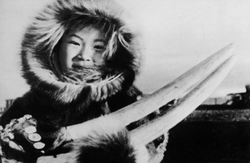Siberian Yup'ik

A Siberian Yupik woman holding walrus tusks, photo by Nabogatova
|
|
| Total population | |
|---|---|
| (1,010) | |
| Regions with significant populations | |
| Chukchi Peninsula in the Russian Far East, St. Lawrence Island in Alaska | |
|
|
1,728 |
|
|
1,100 |
| Languages | |
| Siberian Yupik, Russian, English | |
| Related ethnic groups | |
| Alutiiq, Central Alaskan Yup'ik | |
Siberian Yupiks, or Yuits, are a Yupik Eskimo people who reside along the coast of the Chukchi Peninsula in the far northeast of the Russian Federation and on St. Lawrence Island in Alaska. They speak Central Siberian Yupik (also known as Yuit), a Yupik language of the Eskimo–Aleut family of languages.
They are also known as Siberian or Asian Eskimo (Russian: эскимосы). The name Yuit (юит, plural: юиты) was officially assigned to them in 1931, at the brief time of the campaign of support of indigenous cultures in the Soviet Union. Their self-designation is Yupighyt (йупигыт) meaning "true people".
Sirenik Eskimos also live in that area, but their extinct language, Sireniki Eskimo, shows many peculiarities among Eskimo languages and is mutually unintelligible with the neighboring Siberian Yupik languages.
The Siberian Yupik on St. Lawrence Island live in the villages of Savoonga and Gambell, and are widely known for their skillful carvings of walrus ivory and whale bone, as well as the baleen of bowhead whales. These even include some "moving sculptures" with complicated pulleys animating scenes such as walrus hunting or traditional dances.
The winter building of Chaplino Eskimos (Ungazighmiit) was a round, dome-shaped building. It is called "yaranga" in the literature, the same word referring also to the similar building of the Chukchi. In the language of Chaplino Eskimos, its name was /məŋtˈtəʁaq/. There was a smaller cabin inside it at its back part, the /aːɣra/, used for sleeping and living. It was separated from the outer, cooler parts of the yaranga with haired reindeer skins and grass, supported by a cage-like framework. But the household works were done in the room of the yaranga in front of this inner building, and also many household utensils were kept there. In winter storms, and at night also the dogs were there. This room for economical purposes was called /naˈtək/.
...
Wikipedia
